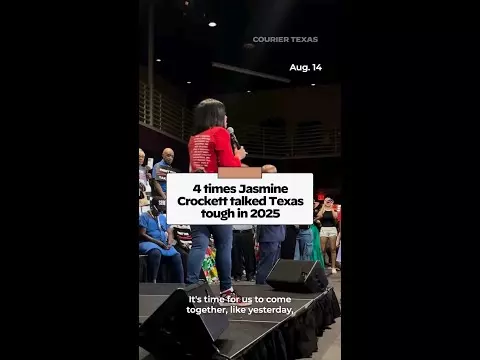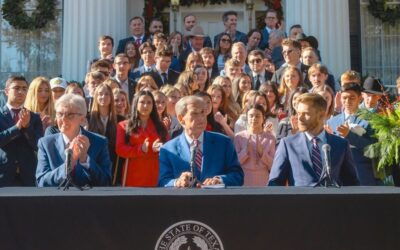
Gov. Greg Abbott signed an $8.5 billion public school funding bill on Wednesday at Salado Middle School after years of refusing to increase money for public education. (Photo by Matt Hennie)
The $8.5 billion Texas public school funding law includes pay raises for teachers and staff, along with more money for special education, operations, and safety measures.
Gov. Greg Abbott delivered $8.5 billion in new funding to the state’s struggling public schools on Wednesday, but only after blocking it for years in order to get his way on a private school voucher program.
Abbott signed the funding measure, House Bill 2, into law during a ceremony at Salado Middle School in Bell County, flanked by lawmakers, educators, and students. The bill boosts pay for teachers and support staff, adds funding for special education, increases by less than 1% the basic per student allotment that pays for operational costs, and assists school districts with meeting state mandates for full-day pre-kindergarten and safety measures.
Abbott said the measure is a step toward his vision of making the state’s public schools the best in the country.
“It’s time that we Texans collectively recast our gaze to Texas being ranked number one for educating the children of the great state of Texas,” Abbott said before signing the bill. “House Bill 2 takes substantial steps toward us achieving that goal. It starts with better funding our schools.”
Yet in 2023, Abbott blocked additional school funding when lawmakers didn’t pass his school voucher plan. And the $55 bump to the basic allotment — which is currently $6,160 per student — is the first increase Abbott has provided since 2019, and it falls well short of the nearly $1,300 school officials said they need to keep up with inflation.
Under HB 2, school districts will also receive $106 per student in new funding to help pay the costs of transportation, insurance, utilities, and employee benefits.
Rep. James Talarico, the Austin Democrat who sits on the House Public Education Committee, said HB 2 falls short of the funding needed for the state’s 1,200 public school districts.
“I would vote for even a penny increase in school funding, but this deal barely scratches the surface of what’s needed to address the school funding crisis that Greg Abbott has created,” Talarico said in a prepared statement.
“Six years ago, Greg Abbott took school funding hostage, forcing school districts across the state to cut teaching positions, shut down programs, and close school campuses. Now, Republican leadership is failing to give our students the resources they need and failing to deliver a pay raise to every Texas teacher,” he added.
Abbott signed the funding measure in Salado ISD, a district with three schools and about 2,200 students. Under HB 2, Salado ISD will receive an additional $2 million in the upcoming school year, according to Texas AFT, a union for public school employees. Salado is in the legislative district of Rep. Brad Buckley, the Republican author of HB 2 and chair of the House Public Education Committee that approved the bill.
“There’s never been a more important time to put the resources in the hands of our educators for us to be number one,” Buckley told the crowd.
JoMeka Gray, a kindergarten teacher in Temple ISD who was named Region 12 Teacher of the Year in 2024, sat beside Abbott and applauded the bill. HB 2 provides about $4.5 million in new funding to her 8,000-student school district next year.
“I know this is gonna be a big stepping stone for all of our 5.5 million students that we have here in Texas, including my two children,” Gray told Courier Texas. “ With the $8.5 billion, it makes a huge difference.”
Nearly half of the funding — about $4 billion — provides raises for teachers and staff, and expands the state’s merit-based pay program called the Teacher Incentive Allotment. Teachers will receive up to $8,000, though the raises are geared toward educators in smaller districts.
Teachers with five or more years of experience in districts with fewer than 5,000 students will get an $8,000 raise, while those with three to four years experience will receive $4,000. The raises are capped at $5,000 for the most experienced teachers in districts with more than 5,000 students.
Abbott’s appearance at the Salado school was his first public event in a public school in months, if not years. In the months leading up to the legislative session, and during the 140 days lawmakers were at the Texas Capitol, Abbott only visited private religious schools to lobby for his school voucher plan. He signed a $1 billion voucher plan, which provides public funds for parents to pay for their child’s private school tuition, on May 3.
Abbott’s office did not respond Thursday to a question about the governor’s last stop at a public school.
While Abbott enjoyed a victory lap on Wednesday to celebrate the funding bill, the governor — who took office in 2015 — has had a decade to improve public education. Instead, he’s fueled culture wars against LGBTQ+ students, school libraries, and diversity, equity and inclusion initiatives; and worked with Republican lawmakers to infuse Christianity into public schools.
This year, lawmakers passed bills requiring the Ten Commandments to be displayed in classrooms and allowing a period of prayer and reading of the Bible or other religious text.
In November, the Texas Board of Education approved Bluebonnet Learning, which are learning materials for kindergarten through eighth-grade students infused with a Bible-based curriculum and factual inaccuracies. In 2021, lawmakers mandated that schools display “In God We Trust” signs if they are donated by a private foundation.
Here’s what HB 2 provides, according to Abbott’s office and Texas AFT
- $4.2 billion for teacher and staff pay raises and expansion of the Teacher Incentive Allotment
- $1.3 billion for school district operational costs, including insurance, transportation, utilities, and contributions to the Teacher Retirement System of Texas
- $834 million for special education reforms
- $648 million targeted to strategies for improving reading and math skills
- $500 million for support staff and paraprofessional raises
- $430 million to increase the school safety allotment
- $318 million to provide additional funding to small and rural schools
- $296 million for adjustments to the Tier II funding formula, which equalizes funding between low-income and wealthy school districts. (This funding includes the $55 per student increase in the basic allotment)
- $199 million to expand the charter school facilities allotment
- $187 million for teacher preparation and certification programs
Support Our Cause
Thank you for taking the time to read our work. Before you go, we hope you'll consider supporting our values-driven journalism, which has always strived to make clear what's really at stake for Texans and our future.
Since day one, our goal here at COURIER Texas has always been to empower people across the state with fact-based news and information. We believe that when people are armed with knowledge about what's happening in their local, state, and federal governments—including who is working on their behalf and who is actively trying to block efforts aimed at improving the daily lives of Texas families—they will be inspired to become civically engaged.















